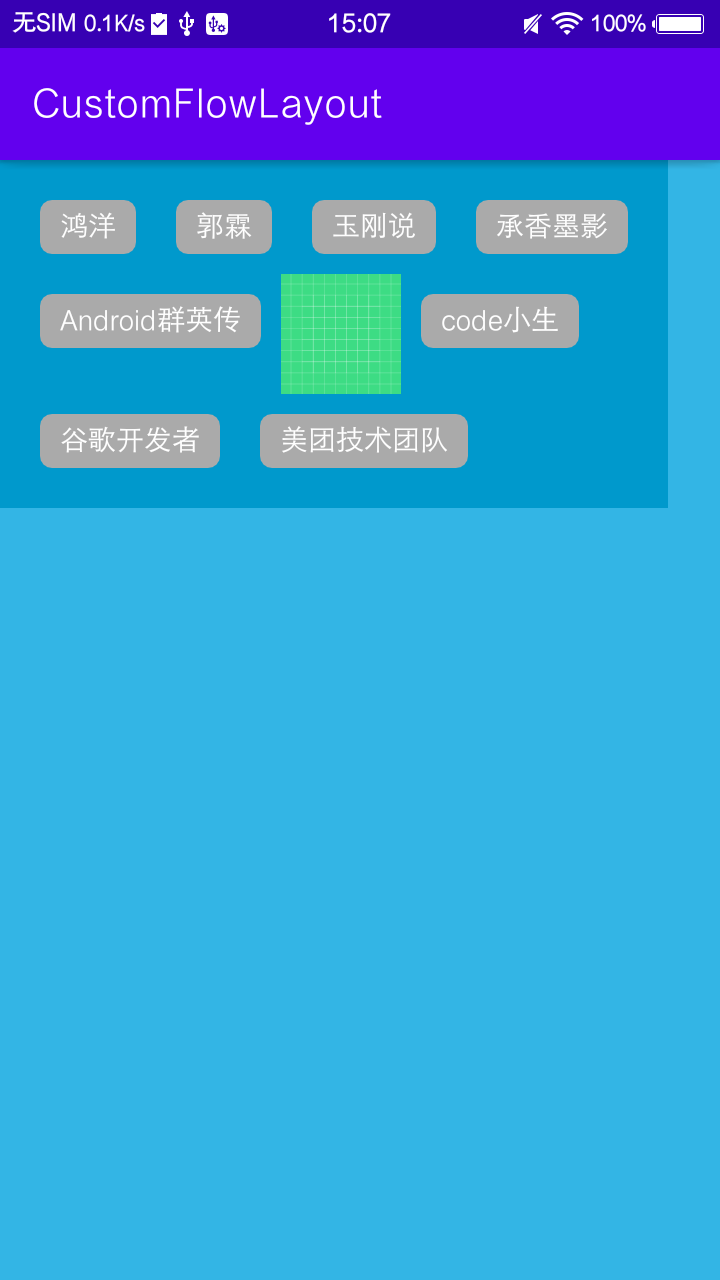标签:dimens image onlayout prot 地址 androi private 自定义 OLE

自定义ViewGroup的步骤是
/**
* 获取子view的个数
* 逐个测量其宽高 得到整个ViewGroup的宽高
*
* @param widthMeasureSpec
* @param heightMeasureSpec
*/
@Override
protected void onMeasure(int widthMeasureSpec, int heightMeasureSpec) {
super.onMeasure(widthMeasureSpec, heightMeasureSpec);
//获取流式布局的宽度和模式
int widthSize = MeasureSpec.getSize(widthMeasureSpec);
int widthMode = MeasureSpec.getMode(widthMeasureSpec);
//获取流式布局的高度和模式
int heightSize = MeasureSpec.getSize(heightMeasureSpec);
int heightMode = MeasureSpec.getMode(heightMeasureSpec);
//使用wrap_content的流式布局的最终宽度和高度
int width = 0, height = 0;
//记录每一行的宽度和高度
int lineWidth = 0, lineHeight = 0;
//得到内部元素的个数
int count = getChildCount();
mChildPos.clear();
for (int i = 0; i < count; i++) {
//获取对应索引的view
View child = getChildAt(i);
//测量子view的宽和高
measureChild(child, widthMeasureSpec, heightMeasureSpec);
MarginLayoutParams lp = (MarginLayoutParams) child.getLayoutParams();
//子view占据的宽度
int childWidth = child.getMeasuredWidth() + lp.leftMargin + lp.rightMargin;
//子view占据的高度
int childHeight = child.getMeasuredHeight() + lp.topMargin + lp.bottomMargin;
//换行
if (lineWidth + childWidth > widthSize - getPaddingLeft() - getPaddingRight()) {
//取最大的行宽为流式布局宽度
width = Math.max(width, lineWidth);
//叠加行高得到流式布局高度
height += lineHeight;
//重置行宽度为第一个View的宽度
lineWidth = childWidth;
//重置行高度为第一个View的高度
lineHeight = childHeight;
//记录位置
mChildPos.add(new ChildPos(
getPaddingLeft() + lp.leftMargin,
getPaddingTop() + height + lp.topMargin,
getPaddingLeft() + childWidth - lp.rightMargin,
getPaddingTop() + height + childHeight - lp.bottomMargin));
} else { //不换行
//记录位置
mChildPos.add(new ChildPos(
getPaddingLeft() + lineWidth + lp.leftMargin,
getPaddingTop() + height + lp.topMargin,
getPaddingLeft() + lineWidth + childWidth - lp.rightMargin,
getPaddingTop() + height + childHeight - lp.bottomMargin));
//叠加子View宽度得到新行宽度
lineWidth += childWidth;
//取当前行子View最大高度作为行高度
lineHeight = Math.max(lineHeight, childHeight);
}
//最后一个控件
if (i == count - 1) {
width = Math.max(lineWidth, width);
height += lineHeight;
}
}
// 得到最终的宽高
// 宽度:如果是AT_MOST模式,则使用我们计算得到的宽度值,否则遵循测量值
// 高度:只要布局中内容的高度大于测量高度,就使用内容高度(无视测量模式);否则才使用测量高度
int flowLayoutWidth = widthMode == MeasureSpec.AT_MOST ? width + getPaddingLeft() + getPaddingRight() : widthSize;
int flowLayoutHeight = heightMode == MeasureSpec.AT_MOST ? height + getPaddingTop() + getPaddingBottom() : heightSize;
//真实高度
realHeight = height + getPaddingTop() + getPaddingBottom();
//测量高度
measuredHeight = heightSize;
if (heightMode == MeasureSpec.EXACTLY) {
realHeight = Math.max(measuredHeight, realHeight);
}
// 设置最终的宽高
setMeasuredDimension(flowLayoutWidth, flowLayoutHeight);
}
在测量的过程中就可以获取到每一个子控件的位置,直接缓存,在onLayout中可以直接遍历摆放。
private class ChildPos {
int left, top, right, bottom;
public ChildPos(int left, int top, int right, int bottom) {
this.left = left;
this.top = top;
this.right = right;
this.bottom = bottom;
}
}
@Override
protected void onLayout(boolean changed, int l, int t, int r, int b) {
int count = getChildCount();
for (int i = 0; i < count; i++) {
View child = getChildAt(i);
ChildPos pos = mChildPos.get(i);
//设置View的左边、上边、右边底边位置
child.layout(pos.left, pos.top, pos.right, pos.bottom);
}
}
注意:
需要重写generateLayoutParams 返回MarginLayoutParams才可以在onMeasure中获取到控件的Margin值
@Override
public LayoutParams generateLayoutParams(AttributeSet attrs) {
return new MarginLayoutParams(getContext(), attrs);
}
标签:dimens image onlayout prot 地址 androi private 自定义 OLE
原文地址:https://www.cnblogs.com/tomarsNi/p/13994363.html